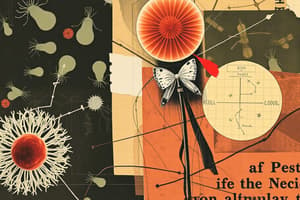Podcast
Questions and Answers
What is the main purpose of using culture media in bacteriology labs?
What is the main purpose of using culture media in bacteriology labs?
- To identify the cause of infection from clinical samples
- To study the characteristics of microorganisms
- To prepare biological products like vaccines and toxoids
- All of the above (correct)
What is the most commonly used solidifying agent in solid media?
What is the most commonly used solidifying agent in solid media?
- Peptone
- Meat extract
- NaCl
- Agar (correct)
What is the main characteristic of semi-solid media?
What is the main characteristic of semi-solid media?
- They are liquid and used for bacterial separation
- They are hard and used for bacterial growth
- They are soft and used for demonstrating bacterial motility (correct)
- They are complex and used for research purposes
What is the composition of Nutrient Broth (NB)?
What is the composition of Nutrient Broth (NB)?
What is the purpose of using synthetic or defined media?
What is the purpose of using synthetic or defined media?
What is the difference between complex media and synthetic media?
What is the difference between complex media and synthetic media?
What is the main characteristic of liquid media?
What is the main characteristic of liquid media?
What is an example of a simple medium?
What is an example of a simple medium?
What is the primary purpose of MacConkey agar?
What is the primary purpose of MacConkey agar?
Which agar is used for the cultivation of pathogens from urine specimens and inhibits the swarming of Proteus sp.?
Which agar is used for the cultivation of pathogens from urine specimens and inhibits the swarming of Proteus sp.?
What is the purpose of Stuart's medium?
What is the purpose of Stuart's medium?
What should be done to prevent burning of agar during media preparation?
What should be done to prevent burning of agar during media preparation?
What is the purpose of covering the top of the flask or jar with aluminum foil during media sterilization?
What is the purpose of covering the top of the flask or jar with aluminum foil during media sterilization?
What is the primary purpose of TCBS agar?
What is the primary purpose of TCBS agar?
What is the purpose of XLD agar?
What is the purpose of XLD agar?
How much media should be poured into each petri plate during media preparation?
How much media should be poured into each petri plate during media preparation?
What is the main purpose of adding substances like blood, serum, or egg to a simple medium?
What is the main purpose of adding substances like blood, serum, or egg to a simple medium?
What is the purpose of adding vancomycin to Thayer Martin medium?
What is the purpose of adding vancomycin to Thayer Martin medium?
What is the function of methylene blue in Eosin methylene blue medium?
What is the function of methylene blue in Eosin methylene blue medium?
What is the purpose of Lowenstein-Jensen medium?
What is the purpose of Lowenstein-Jensen medium?
What type of media is used to recognize different bacteria based on their colony color?
What type of media is used to recognize different bacteria based on their colony color?
What is the purpose of adding antibiotics to selective media?
What is the purpose of adding antibiotics to selective media?
What is the purpose of using Blood agar?
What is the purpose of using Blood agar?
What type of media is used to isolate Neisseria gonorrhoeae?
What type of media is used to isolate Neisseria gonorrhoeae?
Flashcards are hidden until you start studying
Study Notes
Culture Media
Definition and Uses
- Culture medium: food material or substances required for growing microorganisms in vitro
- Uses:
- Identify the cause of infection from clinical samples for proper treatment
- Study characteristics or properties of microorganisms
- Prepare biological products like vaccines, toxoids, and antigens
Composition
- Water
- Energy source
- Carbon source
- Nitrogen source
- Mineral salts
- Special growth factors
Types of Culture Media
Classification Based on Physical State
- Solid medium: agar is the most commonly used solidifying agent
- Semi-solid medium: soft and useful in demonstrating bacterial motility and separating motile from non-motile strains
- Liquid medium: also referred to as "broth", bacteria grow uniformly producing general turbidity (e.g., Nutrient broth)
Classification Based on Ingredients
- Simple media: e.g., Nutrient broth, N. agar
- Complex media: e.g., blood agar, ingredients difficult to estimate
- Synthetic or defined media: specially prepared media from pure chemical substances for research purposes (e.g., peptone water)
- Special media:
- Enriched media: add substances like blood, serum, or egg to simple medium (e.g., Blood agar, Chocolate agar)
- Selective media: inhibitory substances added to inhibit commensal or contaminating bacteria (e.g., Thayer Martin medium, Eosin methylene blue)
- Differential media: designed to recognize bacteria based on colony color (e.g., MacConkey agar, XLD agar)
- Transport media: used for transporting samples, delicate organisms may not survive without it (e.g., Stuart's medium, Buffered glycerol saline)
- Anaerobic media: used for growing anaerobic bacteria
Media Preparation
- Assemble all chemicals in the work area
- Accurately weigh each dry ingredient
- Add distilled water to the correct volume
- Heat and stir until all ingredients are in solution
- Sterilize using the wet cycle (autoclave)
Media Sterilization
- Sterilize by using the wet cycle (autoclave)
- Cover the top of the flask or jar with aluminum foil
- Line up sterile petri plates
- Pour 15-20 ml of media into each petri plate
- Keep the petri plate lid slightly open to prevent contamination
Studying That Suits You
Use AI to generate personalized quizzes and flashcards to suit your learning preferences.




